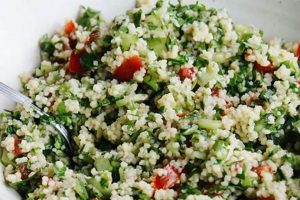Nutritious and flavorful meal options incorporating fresh produce, lean proteins, and beneficial fats are essential for a balanced diet. For example, a combination of leafy greens, grilled chicken breast, avocado, and a light vinaigrette offers a complete and satisfying meal. Such dishes can be customized with a variety of ingredients to cater to individual preferences and dietary needs.
Consuming meals rich in fruits and vegetables provides essential vitamins, minerals, and antioxidants, contributing to overall health and well-being. These meals often offer lower caloric density compared to processed foods, supporting weight management. Historically, salads have evolved from simple combinations of raw greens to complex and creative culinary expressions, reflecting changing dietary understandings and cultural influences.
The following sections will explore various aspects of creating and enjoying these wholesome meals, including selecting appropriate ingredients, understanding flavor combinations, and preparing dressings that enhance both taste and nutritional value. Practical tips and suggested recipes will be provided to facilitate the incorporation of these dishes into a healthy lifestyle.
Tips for Creating Nutritious and Flavorful Salads
Creating appealing and healthful meals based on fresh ingredients requires careful consideration of various factors, from ingredient selection to preparation techniques. The following tips offer guidance for maximizing both nutritional value and culinary enjoyment.
Tip 1: Prioritize Fresh, Seasonal Produce: Selecting in-season fruits and vegetables ensures optimal flavor and nutrient content. Farmers’ markets are excellent resources for sourcing fresh, locally grown produce.
Tip 2: Embrace Variety: Incorporating a diverse range of colorful vegetables and fruits maximizes the spectrum of vitamins and minerals consumed. Consider combining leafy greens with cruciferous vegetables, root vegetables, and vibrant fruits.
Tip 3: Choose Lean Protein Sources: Grilled chicken breast, fish, beans, lentils, and tofu provide essential protein without excessive saturated fat. These options contribute to satiety and support muscle maintenance.
Tip 4: Incorporate Healthy Fats: Avocados, nuts, seeds, and olive oil provide beneficial monounsaturated and polyunsaturated fats. These fats contribute to heart health and enhance the absorption of fat-soluble vitamins.
Tip 5: Prepare Homemade Dressings: Commercially prepared dressings often contain added sugars and unhealthy fats. Creating dressings at home allows for control over ingredients and flavor profiles.
Tip 6: Experiment with Herbs and Spices: Fresh herbs and spices add depth and complexity to flavor profiles without adding excess sodium or calories. Consider using basil, mint, cilantro, ginger, or turmeric.
Tip 7: Utilize Whole Grains: Adding quinoa, brown rice, or farro to salads provides fiber and complex carbohydrates, contributing to sustained energy levels.
By following these guidelines, individuals can create meals that are both delicious and supportive of overall health and well-being. These strategies promote balanced nutrition and culinary satisfaction.
In conclusion, prioritizing fresh ingredients, embracing variety, and employing mindful preparation techniques contribute to the creation of meals that nourish the body and delight the palate. Further exploration of specific recipes and dietary considerations will be presented in subsequent sections.
1. Fresh, Seasonal Ingredients
Utilizing fresh, seasonal ingredients is paramount in crafting truly nutritious and flavorful salads. Seasonality dictates peak ripeness, resulting in produce bursting with both flavor and nutrients. This heightened nutritional value translates to a more impactful contribution to overall dietary health. For example, tomatoes harvested at their peak during summer months offer significantly higher concentrations of lycopene, a potent antioxidant, compared to those harvested out of season. Similarly, leafy greens harvested in cooler months often exhibit a sweeter, more delicate flavor and tender texture. This connection between seasonality and nutritional density underscores the importance of incorporating fresh, in-season produce as a foundation for health-conscious salad preparation.
Choosing seasonal ingredients also offers practical advantages. Locally sourced, in-season produce generally requires less transportation and storage, reducing its environmental impact. Furthermore, the abundance of specific produce during its peak season often translates to lower market prices, making healthy eating more accessible. Farmers’ markets and local farms provide excellent resources for procuring the freshest, in-season ingredients. Building salads around what is readily available encourages culinary creativity and fosters a deeper connection with the natural cycles of food production. A winter salad might showcase roasted root vegetables like beets and carrots, while a summer salad might feature juicy watermelon and fresh basil.
In conclusion, prioritizing fresh, seasonal ingredients elevates salads from simple meals to vibrant expressions of flavor and nutrition. This practice supports both individual well-being and sustainable food systems. By aligning dietary choices with the natural rhythm of the seasons, individuals can maximize the nutritional benefits and culinary enjoyment derived from their salads. The impact extends beyond personal health to encompass broader considerations of environmental responsibility and economic accessibility.
2. Variety of Textures
Textural diversity plays a crucial role in the palatability and enjoyment of salads, influencing overall satisfaction and promoting healthful eating habits. A combination of crisp, crunchy, creamy, and chewy elements elevates a salad from a simple dish to a more complex and engaging culinary experience. This variety stimulates sensory receptors, enhancing the perception of flavors and contributing to a more satisfying meal. The interplay of textures also encourages thorough mastication, which aids digestion and nutrient absorption. For instance, a salad combining crisp romaine lettuce, crunchy toasted almonds, creamy avocado, and chewy dried cranberries offers a more stimulating and satisfying experience than one solely comprised of leafy greens.
Beyond sensory appeal, textural variety in salads offers practical nutritional benefits. Incorporating ingredients with diverse textures often necessitates a wider range of produce and other healthful components. This naturally leads to a greater diversity of vitamins, minerals, and phytochemicals within the meal. Crunchy elements like nuts and seeds contribute healthy fats and fiber, while creamy components like avocado provide additional healthy fats and vitamins. Furthermore, the inclusion of various textures can make salads more appealing to individuals who might otherwise find them monotonous, thereby encouraging increased consumption of nutrient-rich plant-based foods. A salad featuring roasted chickpeas, chopped bell peppers, crumbled feta cheese, and a light vinaigrette exemplifies this principle, offering a compelling combination of flavors and textures while delivering a diverse array of nutrients.
Incorporating a range of textures is essential for creating salads that are both nutritionally balanced and genuinely enjoyable. This approach promotes increased consumption of fresh produce and other healthful ingredients while enhancing the overall dining experience. The strategic combination of textures elevates a salad from a basic dish to a more compelling and satisfying meal, contributing to long-term adherence to healthy dietary patterns. Understanding the impact of textural variety allows for the creation of salads that not only nourish the body but also engage the senses and promote a more positive relationship with healthful eating.
3. Balanced Flavor Profiles
The creation of palatable and healthful salads hinges on the careful orchestration of flavor profiles. A balanced flavor profile, incorporating sweet, sour, salty, bitter, and umami elements, is essential for maximizing enjoyment and promoting consistent consumption of nutrient-rich ingredients. A well-balanced salad is not merely a collection of healthy components; it is a cohesive culinary creation that stimulates the palate and encourages long-term adherence to healthy eating patterns.
- Sweetness
Sweetness, often derived from fruits, roasted vegetables, or even a touch of honey or maple syrup in the dressing, provides a foundational element of balance. It tempers acidity and bitterness, creating a more rounded flavor profile. Examples include roasted sweet potatoes, ripe berries, or a balsamic glaze. Incorporating sweetness strategically enhances the overall palatability of the salad, making it more appealing and enjoyable.
- Acidity
Acidity, typically introduced through vinegar, citrus juice, or fermented ingredients, provides brightness and complexity. It cuts through richness and adds a refreshing counterpoint to other flavors. Examples include lemon juice, red wine vinegar, or pickled onions. Acidity also plays a crucial role in balancing sweetness and enhancing the perception of other taste components.
- Saltiness
Saltiness, while used judiciously, is essential for enhancing flavors and creating depth. It can be introduced through ingredients like olives, cheeses, or a sprinkle of sea salt. However, mindful use is crucial to avoid overpowering other flavors and maintaining healthfulness. A small amount of high-quality salt can significantly elevate the overall flavor profile without compromising nutritional goals.
- Bitterness and Umami
Bitterness, found in leafy greens like kale or arugula, and umami, present in ingredients like mushrooms or seaweed, add complexity and depth to a salad. These elements, often overlooked, contribute significantly to a well-rounded flavor profile. They provide a counterpoint to sweetness and richness, preventing the salad from becoming overly one-dimensional. Balancing these flavors can broaden the appeal of salads and introduce individuals to a wider range of nutrient-rich ingredients.
By thoughtfully combining these five elements, individuals can create salads that are not only nutritionally dense but also genuinely delicious. This approach encourages regular consumption of fresh produce and other healthful ingredients, contributing to long-term health and well-being. A salad featuring grilled chicken, mixed greens, roasted beets, goat cheese, and a lemon-herb vinaigrette exemplifies a balanced flavor profile, demonstrating how these elements can harmonize to create a satisfying and nutritious meal.
4. Nutrient-Rich Dressings
Nutrient-rich dressings are essential for maximizing the health benefits and enjoyment of salads. While fresh produce provides a foundation of vitamins and minerals, a carefully crafted dressing can elevate a salad from a simple combination of ingredients to a nutritionally complete and flavorful meal. Dressings contribute not only to taste but also to the bioavailability of certain nutrients, enhancing the overall nutritional value of the salad.
- Healthy Fats as a Base
Dressings based on extra virgin olive oil, avocado oil, or flaxseed oil provide monounsaturated and polyunsaturated fats, which contribute to heart health and enhance the absorption of fat-soluble vitamins present in the salad ingredients. These oils also offer a smooth, palatable texture and serve as a vehicle for distributing flavors throughout the salad. For example, a simple vinaigrette made with extra virgin olive oil and lemon juice provides a foundation of healthy fats while adding brightness and acidity.
- Flavor Enhancement with Herbs and Spices
Fresh herbs and spices contribute not only complex flavors but also a range of antioxidants and other beneficial compounds. Incorporating herbs like parsley, dill, or oregano, and spices like turmeric, ginger, or cumin, enhances the nutritional profile of the dressing while adding depth and complexity to the salad’s overall flavor. A dressing featuring chopped cilantro, lime juice, and a touch of chili powder exemplifies this principle, delivering a vibrant flavor profile with potential health benefits.
- Acidity for Balance and Nutrient Absorption
The acidity in dressings, often derived from vinegar or citrus juice, not only balances flavors but also enhances the absorption of certain nutrients, particularly iron and zinc, from the salad ingredients. This is especially important for individuals following plant-based diets. Lemon juice, apple cider vinegar, or red wine vinegar are excellent choices for adding acidity to dressings. For example, a vinaigrette with balsamic vinegar provides both flavor and enhanced nutrient absorption.
- Minimizing Added Sugars and Processed Ingredients
Commercially prepared dressings often contain high levels of added sugars, unhealthy fats, and artificial ingredients. Creating dressings at home allows for complete control over ingredients, ensuring a focus on nutrient density. This approach supports overall health goals and minimizes exposure to potentially harmful additives. A simple homemade dressing of olive oil, lemon juice, and herbs demonstrates this principle, providing flavor and nutrition without unnecessary additives.
By focusing on these key aspects, individuals can create nutrient-rich dressings that not only enhance the flavor and enjoyment of salads but also contribute significantly to their nutritional value. This approach elevates the salad from a simple side dish to a nutritionally complete and satisfying meal, supporting overall health and well-being. Incorporating a variety of nutrient-rich dressings into one’s dietary repertoire further contributes to dietary diversity and maximizes the intake of beneficial compounds.
5. Mindful Portion Sizes
Portion control plays a crucial role in realizing the health benefits of salads. Even nutrient-rich foods, when consumed in excess, can contribute to weight gain and other health concerns. Understanding appropriate portion sizes allows individuals to maximize the nutritional advantages of salads while maintaining a balanced dietary intake. This involves considering not only the volume of the salad itself but also the composition of ingredients and their respective caloric densities.
- Calorie Awareness
Calorie awareness is fundamental to mindful portioning. While salads comprised primarily of vegetables are generally low in calories, the addition of high-calorie ingredients like cheese, nuts, seeds, and certain dressings can significantly increase the overall caloric density. Understanding the caloric contribution of each ingredient allows for informed choices that align with individual dietary goals. For example, a salad featuring a large portion of avocado, while rich in healthy fats, can contribute significantly to the total calorie count. Balancing these higher-calorie ingredients with lower-calorie options like leafy greens and non-starchy vegetables ensures a balanced and calorie-conscious meal.
- Plate Composition
Visualizing plate composition can aid in portion control. A helpful guideline is to fill half the plate with non-starchy vegetables, one-quarter with lean protein, and one-quarter with whole grains or starchy vegetables. This framework promotes balanced nutrition and helps manage overall portion sizes. For instance, a salad containing a palm-sized portion of grilled chicken, a cup of quinoa, and a generous serving of mixed greens reflects this balanced approach. This visual representation facilitates portion awareness and encourages a balanced intake of essential nutrients.
- Satiety Signals
Paying attention to satiety signals is crucial for mindful eating. Consuming salads slowly and mindfully allows individuals to recognize feelings of fullness and avoid overeating. Fiber-rich vegetables and lean proteins contribute to satiety, promoting a sense of fullness and reducing the likelihood of overconsumption. Recognizing these internal cues is essential for regulating food intake and maintaining a healthy weight. Focusing on the sensory experience of eating the salad, rather than distractions, further enhances this awareness.
- Meal Context
Considering the context of the meal also influences appropriate portion sizes. A salad served as a main course will likely require a larger portion size than a salad served as a side dish. Adjusting portion sizes according to the meal’s role within the overall dietary plan ensures balanced calorie intake throughout the day. A smaller salad featuring a variety of vegetables and a light vinaigrette might suffice as a side dish, while a larger salad with added protein and whole grains would be more appropriate as a main course. This adaptability allows salads to play a versatile role in a balanced dietary pattern.
By integrating these considerations, individuals can effectively manage portion sizes and optimize the health benefits of salads. Mindful portioning allows salads to contribute to a balanced and sustainable dietary pattern, supporting both weight management and overall well-being. This approach transforms the salad from a simple dish into a powerful tool for achieving long-term health goals.
Frequently Asked Questions About Healthy Salads
This section addresses common inquiries regarding the creation and consumption of nutritious and flavorful salads.
Question 1: How can salads be made more satisfying and prevent feelings of hunger shortly after eating?
Incorporating lean protein sources, such as grilled chicken, fish, beans, or lentils, and healthy fats, like avocado, nuts, or seeds, contributes significantly to satiety and sustained energy levels. Fiber-rich ingredients, such as whole grains and cruciferous vegetables, also promote fullness.
Question 2: Are all salad dressings healthy?
Commercially prepared dressings often contain high levels of added sugars, unhealthy fats, and artificial ingredients. Homemade dressings, utilizing olive oil, vinegar, herbs, and spices, offer a healthier and more flavorful alternative. Portion control, even with healthy dressings, remains important.
Question 3: Can salads be a complete meal?
Absolutely. Salads can constitute a complete and balanced meal when they incorporate a variety of nutrient-rich ingredients, including lean protein, healthy fats, complex carbohydrates, and a wide range of vitamins and minerals from diverse vegetables and fruits.
Question 4: How can one minimize the environmental impact of salad consumption?
Prioritizing locally sourced, seasonal produce reduces transportation distances and associated environmental impacts. Minimizing food waste through proper storage and utilizing vegetable scraps in stocks or compost further contributes to sustainability.
Question 5: Are there specific vegetables that are more nutritious for salads?
Dark leafy greens, such as spinach, kale, and romaine lettuce, offer high concentrations of vitamins and minerals. Cruciferous vegetables, like broccoli and cauliflower, provide additional nutrients and fiber. Variety remains key for maximizing nutrient intake.
Question 6: How can salads be adapted for various dietary restrictions?
Salads offer inherent adaptability. Vegan diets can utilize plant-based proteins like tofu or tempeh. Gluten-free diets can omit croutons or choose gluten-free grains. Adjustments to ingredients and dressings can accommodate most dietary needs.
Prioritizing fresh, seasonal produce, incorporating lean protein and healthy fats, and crafting nutrient-rich dressings are key to creating salads that contribute to both enjoyment and well-being. Mindful portion sizes and consideration of dietary needs further enhance the health benefits of regular salad consumption.
The following section will provide practical examples of healthy salad recipes incorporating these principles.
Salad Healthy Recipes
Exploration of nutritious salad construction has revealed key components: fresh, seasonal produce; varied textures; balanced flavor profiles achieved through strategic combinations of sweet, sour, salty, bitter, and umami elements; nutrient-rich dressings emphasizing healthy fats, herbs, spices, and minimal processed ingredients; and mindful portioning reflective of caloric awareness and individual dietary needs. These elements synergistically contribute to salads that offer both culinary satisfaction and optimal nutritional value.
Prioritizing these principles transforms salads from simple side dishes to vibrant, healthful centerpieces of a balanced diet. Cultivating an understanding of these components empowers informed choices, fostering a sustainable approach to healthful eating and contributing to long-term well-being. Continued exploration and experimentation with diverse ingredients and flavor combinations promise a journey of culinary discovery and enhanced nutritional intake.






